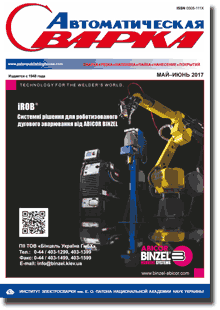| 2017 №06 (11) |
DOI of Article 10.15407/as2017.06.12 |
2017 №06 (13) |

Avtomaticheskaya Svarka (Automatic Welding), #6, 2017, pp. 72-82
Development of a robotic complex for hybrid plasma-arc welding of thin-walled structures
V.N. Korzhik1,2, V.N. Sydorets1,2, Shanguo Han1, A.A. Babich1,2, A.A. Grinyuk2,3 and V.Yu. Khaskin1,2
1Guangdong Welding Institute (China-Ukraine E.O. Paton Institute of Welding) 363 Changxing Str., Tianhe, Guangzhou 510650, China
2E.O. Paton Electric Welding Institute, NASU 11 Kazimir Malevich Str., 03680, Kiev, Ukraine. E-mail: office@paton.kiev.ua
3NTUU «Igor Sikorsky KPI» 37 Pobedi Prosp., 03056, Kiev, Ukraine
Abstract
The objective of this work is development of a complex of equipment and technology of hybrid consumable electrode plasma-arc welding with coaxial wire feed for structures from steels and aluminium alloys 5–12 mm thick, using industrial robots. Mathematical modeling of processes in the arc in hybrid plasma-arc welding was the basis for selection of welding mode parameters allowing for mutual influence of the column of nonconsumable electrode constricted arc and consumable electrode arc, which enabled defining technical requirements to welding current power sources. Proceeding from mathematical and physical modeling of the process of hybrid welding, a complex of equipment and basic technologies were developed for robotic welding of thin-walled structures from steels and aluminium alloys. Developed system of complex control anabled synchronizing the functioning of two welding sources and auxiliary equipment with movements of an anthropomorphic industrial robot for realization of a stable process of hybrid consumable electrode plasma-arc welding. Application of this welding process allowed reducing electrode metal consumption by 40 %, compared to consumable electrode pulsed-arc welding at comparable speeds. Here, the level of longitudinal deflection of welded samples at hybrid process application was 3 times smaller, compared to the process of consumable electrode pulsed-arc welding. 20 Ref., 1 Table, 10 Figures.
Keywords: robotic complex, plasma, consumable electrode arc, hybrid process, aluminium alloys, steels, welding modes, joint quality
Received: 11.05.17
Published: 06.07.17
References
- Skhirtladze, A.G., Bochkarev, S.V., Lykov, A.N. et al. (2013) Automation of technological processes. Moscow: LLC TNT.
- Vodovozov, V.M., Myadzel, V.N., Rassudov, L.N. (1986) Robots in ship hull productions (Control, teaching, algorithmization). Moscow: Sudostroenie. Ovchinnikov, V.V. (2012) Equipment, mechanization and automation of welding processes. Practical work. Moscow: Academiya.
- Essers, W.G., Jelmorini, G. (1975) Method of plasma-MIG-welding. Pat. US3891824. U.S. Philips Corp., USA.
- Essers, W.G., Liefkens, A.C. (1972) Plasma-MIG welding developed by Philips. Machinery and Production Eng., 12, 632–633.
- Essers, W.G., Willemes, G.A. (1984) Plasma-MIG-Schweissen von Aluminium Aufragschweissen und Zweielektrodenschweissen, von autahl. DVS-Berichte, 90, 9–14.
- Dedyukh, R.I. (2014) Specifics of consumable electrode plasma welding process (Review). Proizvodstvo, 5, 34–39.
- Tao Yang, Hongming Gao, Shenghu Zhang et al. (2013) The study on plasma-MIG hybrid arc behaviour and droplet transfer for mild steel welding. Adv. Mater. Sci., 33, 459–464.
- Sydorets, V.N., Zhernosekov, A.M. (2004) Numerical simulation of the system of power source-consumable-electrode arc. The Paton Welding J., 12, 9–15.
- Korzhyk, V., Grynuk, A., Khaskin, V. et al. (2016) The hybrid plasma-arc welding of thin-walled panels made of aluminum alloy. First Independent Sci. J., 12/13, 28–36.
- Ton, H. (1975) Physical properties of the plasma-MIG welding arc. Phys. D: Appl. Phys., 8, 922–933. https://doi.org/10.1088/0022-3727/8/8/006
- Hertel, M., Fuessel, U., Schnick, M. (2014) Numerical simulation of the plasma-MIG process – interactions of the arcs, droplet detachment and weld pool formation. Welding in the World, 58, 85–92. https://doi.org/10.1007/s40194-013-0095-6
- Yang, T., Xu, K., Liu, Y. et al. (2013) Analysis on arc characteristics of plasma-MIG hybrid arc welding. China Welding Inst., 34(5), 62–66.
- Kornienko, A.N., Makarenko, N.A., Granovskij, A.V. et al. (2001) A universal source for plasma-MIG surfacing and welding. Proizvodstvo, 9, 25–26.
- Oliveira, M.A. de, Dutra, J.C. (2007) Electrical model for the plasma-MIG hybrid welding process. Welding & Cutting, 6(6), 324–328.
- Pentegov, I.V., Sidorets, V.N. (1990) Energy parameters in a mathematical model of a dynamic welding arc. Welding International, 4(4), 272–275. https://doi.org/10.1080/09507119009447722
- Pentegov, I.V., Sydorets, V.N. (2015) Comparative analysis of models of dynamic welding arc. The Paton Welding J., 12, 45–48. https://doi.org/10.15407/tpwj2015.12.09
- Pentegov, I.V., Sydorets, V.N. (1991) Quasistatic and dynamic volt-ampere characteristics and time constant of blown and moving arcs. Ibid., 3, 361–364.
- Gao, H.-M., Bai, Y., Wu, L. (2008) Comparison between plasma-MIG and MIG procedures on 5A06 Aluminum Alloy. Sci. Forum, 575–578, 1382–1388. https://doi.org/10.4028/www.scientific.net/MSF.575-578.1382
- Matthes, K.-J., Kohler, T. (2002) Electrical effects and influencing quantities in the case of the hybrid plasma-MIG welding process. Welding & Cutting, 2, 87–90.
